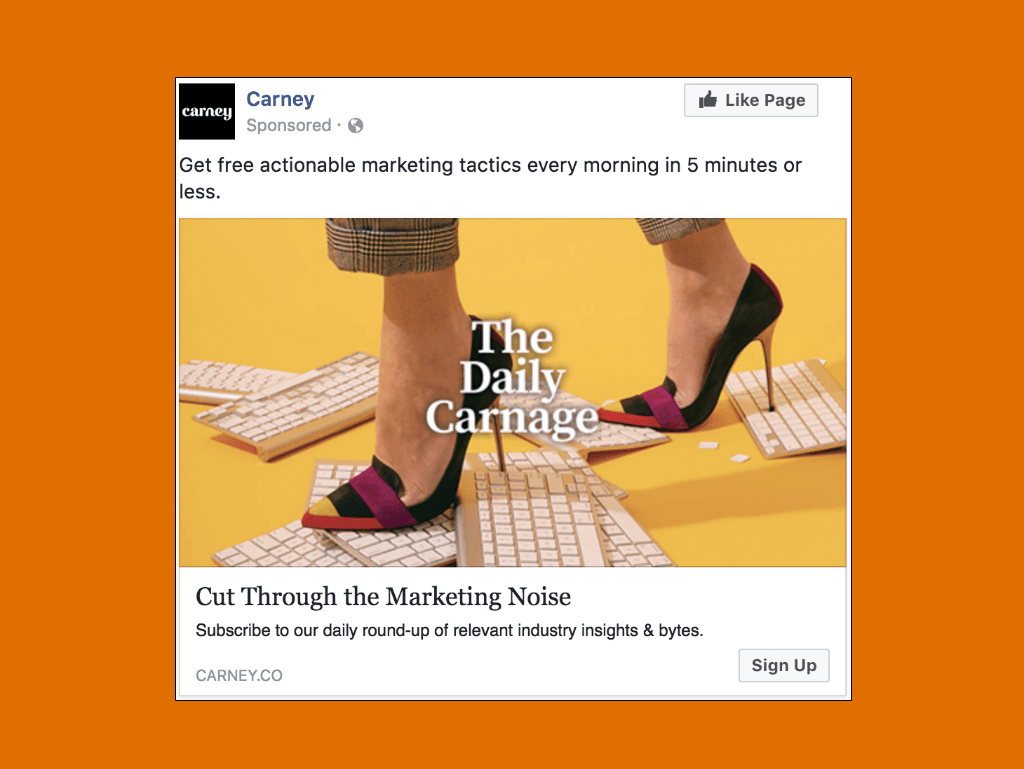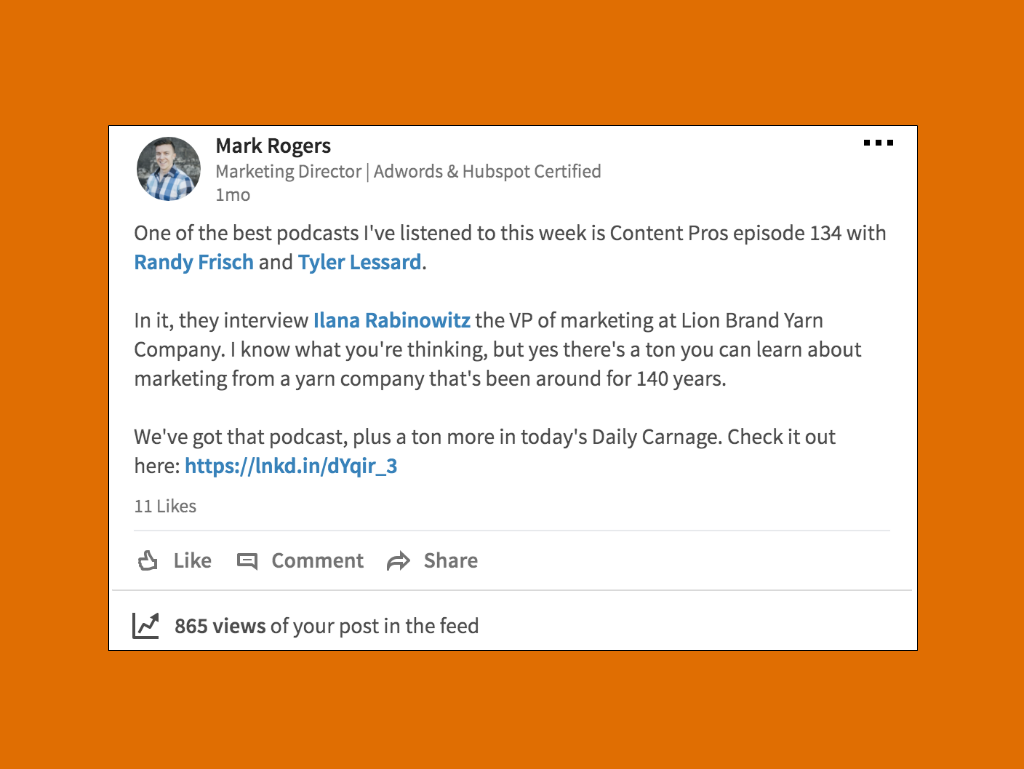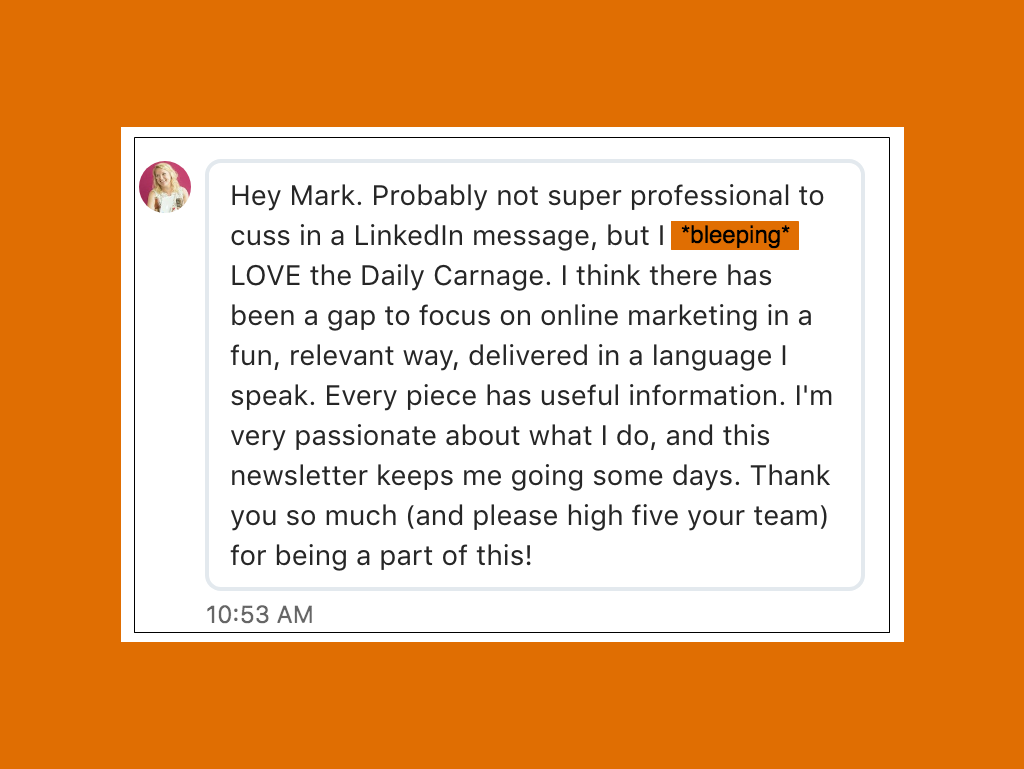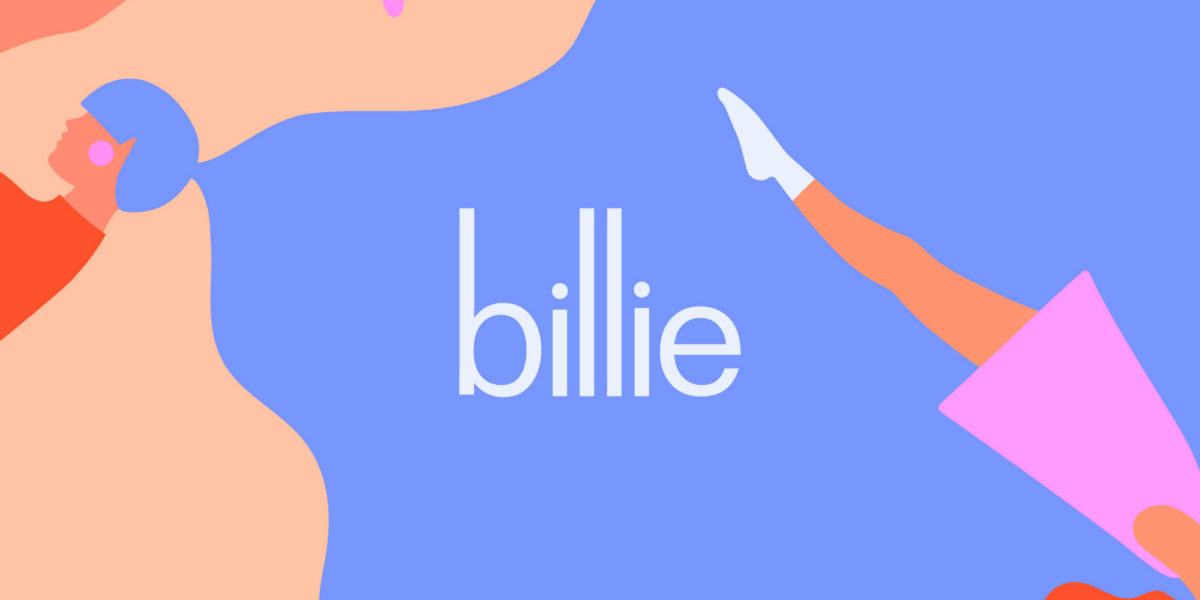In March 2017, we had 271 email subscribers. 271 total subscribers. We made some strategic shifts to our company and knew it was time to build an email list.
We chose email because it’s the closest to 1-1 marketing that you can get. On social media, you live and die by each platform’s algorithm. With email, there is nothing stopping you from getting in front of your subscribers.
Right off the bat, we knew we didn’t want to put a marketing blog at the center of our list building strategy. Let’s be serious; there are more marketing blogs out there than anyone can count. Every agency has one, and every marketing SaaS has one.
Traditional blogging has a ton of benefits, which is why you’re reading this on our blog right now, but we knew our blog couldn’t be the centerpiece of our list building strategy if we wanted to build a huge email list quickly.
We needed to find a way to do something different—to stand out from the noise—so we started brainstorming.
Thinking outside of the box
When we were brainstorming what we were going to do, we kept talking about how more blog content wasn’t the answer. There’s already too much to keep up with. Add in podcasts and videos, and the amount of marketing content is out of control.
Our eureka moment came one morning when our CMO was talking about The Hustle, a daily tech newsletter with about 500,000 subscribers. He loved its voice, and how they succinctly summarized complex tech topics.
That’s when we realized we could do the same thing with marketing blogs. Rather than add to the excess of marketing content, we thought it would make more sense to summarize the best content of the day.
We were already in the habit of sharing and summarizing great marketing content with each other on our internal Slack channel, so it wasn’t a stretch for us to take that content and send it to our email list.
Our next step was to research who else was doing this. We looked around, subscribed to other newsletters, and quickly found that no one was doing what we wanted to do.
We then had to name our newsletter. “Marketing News by Carney” was too dang boring for us. We started using the name “The Daily Carnage” as a placeholder at first, but we liked the way it sounded, and that no one else was using it. So, we kept it.
Development of the voice
More than just doing something that no one else was doing, we had to write it in a voice that no one else was using. Admittedly, we didn’t get it right on the first try. It took us a few months to finally get the voice nailed down.
The voice guidelines we started with were:
- A casual approach
- Written as if we were talking to a friend
- A strong dislike for business-speak and cliche marketing sayings
Those three things were about it. And it worked…slowly. We started to gain new subscribers and noticed a common theme about those new subscribers—the majority of them were women in marketing between 25 and 40 years old. That’s when we made a change in our voice to connect with our core a little more.
We decided to write in the same way that we would text or message a best friend. Texting and messaging is slightly different from how people speak to their friends. When texting, you tend to use a lot of shorthand, slang, abbreviations, and emojis. We figured if our newsletter was going to be read digitally, it should match digital conversations that close friends have.
That change made the newsletter more fun, engaging, and casual, which in turn makes our readers more comfortable.
At the same time, we also made a few changes to add more value to the newsletter:
- Increase the length. we started writing longer summaries so subscribers could get more out of our emails without having to leave the email. We increased the word count per summary from around 100 words to around 300 words.
- Timestamps. We added timestamps to the podcast summaries so that subscribers could jump to a section of the podcast that they were most interested in immediately.
- More fun and entertaining content. We noticed that the traditional marketing videos that we used for the video section every day weren’t getting many clicks, so we removed that and added in a creative advertisement. We also started including a vintage ad each day because who doesn’t love a good ad from the past?
- Increase shareability. We added a section to include a quote about marketing, advertising, or business. Each email features a button to tweet the quote, which gives some shareability to our emails.
- Focus on deliverability. Landing in the inbox, and not the promotions folder, is always a huge focus for email marketing. We do this by keeping a close watch on our inbox reputation.
Once we made all of those changes, we started to see serious subscriber growth. But it still wasn’t enough. We decided to add some fuel to the fire by running Facebook ads for the Daily Carnage.
Facebook ads to gain email subscribers
There are a few rules we always follow when running Facebook ads for clients:
- It starts with the audience. You need to have a well-defined audience based off of your persona.
- You need to have a genuinely eye-catching image to get someone to stop scrolling through their feed and read your ad.
- Copy is crucial. An amazing image will fall flat if the copy is lazy or poorly thought out.
- A well-designed landing page makes or breaks your campaign.
We tested several variations, but when it was all said and done, we had one heck of a high-performing ad. The best version of our ad had:
- A 2.53% Click-through-rate
- A $0.86 cost-per-click
- A relevance score of 8
Here’s the final version of that ad:

Why does that ad work?
- The audience. Remember how I mentioned that the majority of our new subscribers were women in marketing between the ages of 25 and 40? We built the audience to reflect that.
- The creative. We picked an image that would both fit the Carnage and catch our audiences’ eye. High heels stomping on keyboards? Fits everything.
- The copy. It’s succinct but still explains the value a subscriber will get.
How else do we gain subscribers?
Aside from advertising, we have three main strategies for getting new subscribers:
- A referral system. At the bottom of each email, we prompt subscribers to sign up for our referral system. If current subscribers refer friends or coworkers, they get swag — things like stickers, mugs, notebooks, and even socks. The system is simple enough on the front end. But, the backend was a big project. We tried to find an existing tool to run our referral system but nothing exists that does everything we needed it to do. So, we built one ourselves.
- Social media promotion. We always share the web version of our email on social media every day. If you stick with best practices for sharing content, you’ll have success here. It won’t be huge, viral success, but you’ll get some traction.
- Word of mouth. This is the best form of marketing someone can ask for. We do our best to make sure that every email we send is so valuable that people will want to talk about it. It works. We constantly hear from our subscribers that they heard about us from a friend, coworker, internal company intranet, etc.
- Backlinks. We also focus on getting backlinks and mentions from other marketing blogs. We target blogs who have mentioned their favorite marketing resources before and ask for a link. We also sometimes pitch ideas for blog authors to write about. This tactic has a low success rate and can be frustrating, but it’s worth it when it works.
- Manual reach outs. One of the best parts about featuring content from other people is that it gives you a reason to talk to them. Every day, we reach out to the authors of the content we’ve featured in the newsletter, letting them know that we dropped in something they wrote. Those authors often re-share our newsletter with their audiences.
- LinkedIn posts. Another thing we’ve had success with is LinkedIn posts. Once a week or so, I’ll write a post on LinkedIn from my personal account (not Carney’s company page) and tag a few people who were featured in the Daily Carnage. Here’s an example:

This type of promotion is one of the most overlooked parts of content marketing. If you’re not reaching out to people who should read your content, you’re missing out on a bunch of views and shares. It’s time-consuming but always worth it.
Growth or quality?
Once we started to get into the thousands of subscribers, we had a decision to make. Did we just want to focus on how big the list could get, or did we want to focus on having engaged subscribers?
Ultimately, we looked at our goals for the Daily Carnage to make that decision. At the end of the day, we want to get new clients from it, so if we have 20,000 people on our list, but only 10,000 of them open or click our emails on a regular basis, we really only have a 10,000 person list.
For that reason, we decided to prune the list regularly. If a subscriber hasn’t opened any of the last 20 campaigns, which is four weeks of emails, it triggers a re-engagement email. That email gives subscribers the option to stay on the list, or unsubscribe themselves. If that email is ignored, then we do unsubscribe people.
That keeps our open rates high, our engagement high, and keeps us motivated knowing that we’re not wasting our time trying to reach people who don’t want to read the Daily Carnage.
So how’s all of this working for us?
Pretty well. Here are a few basic stats:
- 11,649 subscribers (and that number has grown since writing this).
- 30.0% average open rate
- 4.2% average click rate
- 36.7% highest open rate
- 8.5% highest click rate
Conclusion
Building your email list isn’t easy. Writing the Daily Carnage every day is very time-consuming. We spend time after work and on weekends writing it, but when we get comments like this:

We know it’s all worth it.
The point is, if you want to garner a significant following on social media or through email, you have to be willing to do what other people won’t do. The typical 500-word blog post won’t differentiate you.
And hey, if you wanna see what all the excitement is about with our newsletter, sign up right here.





